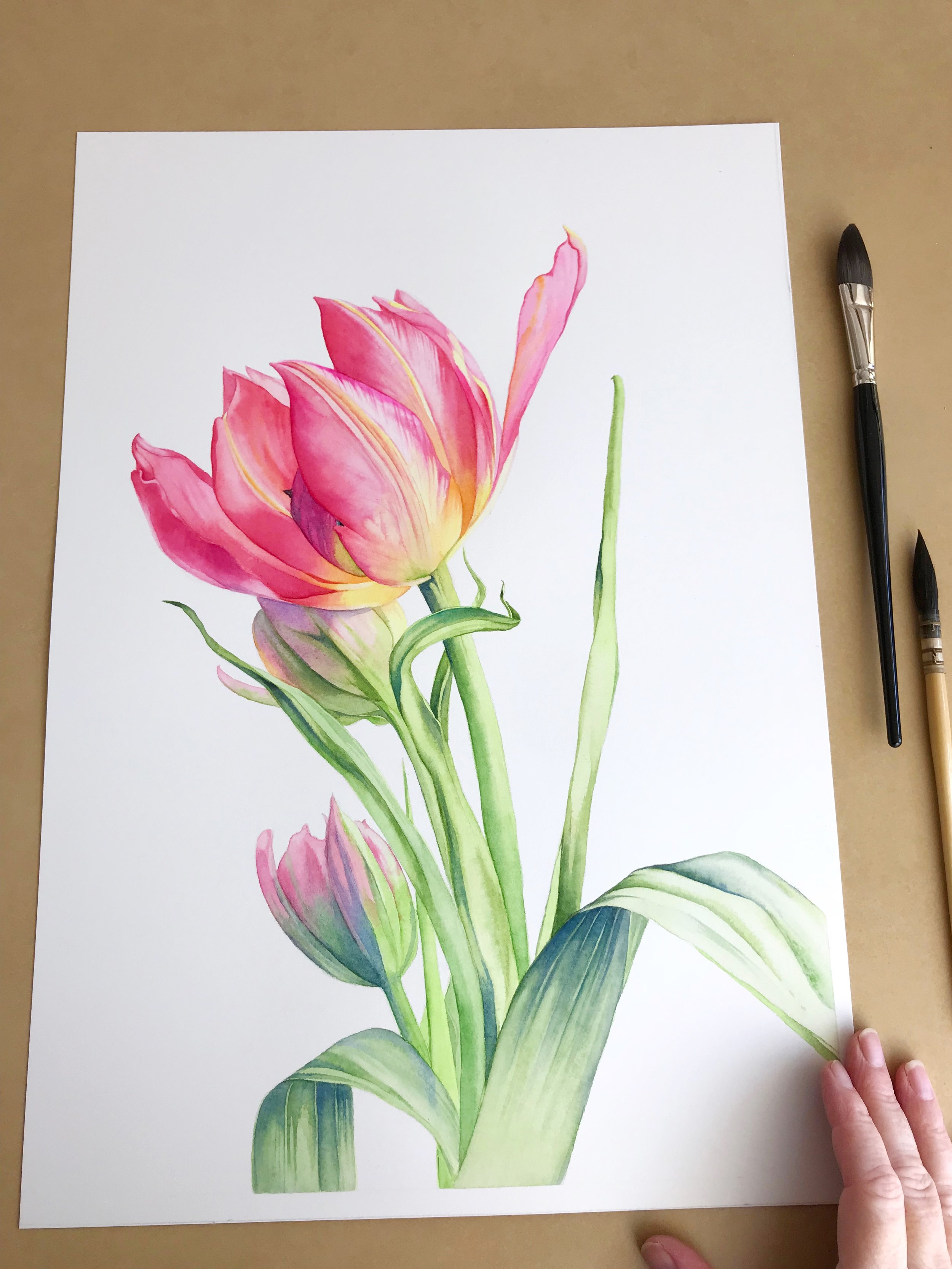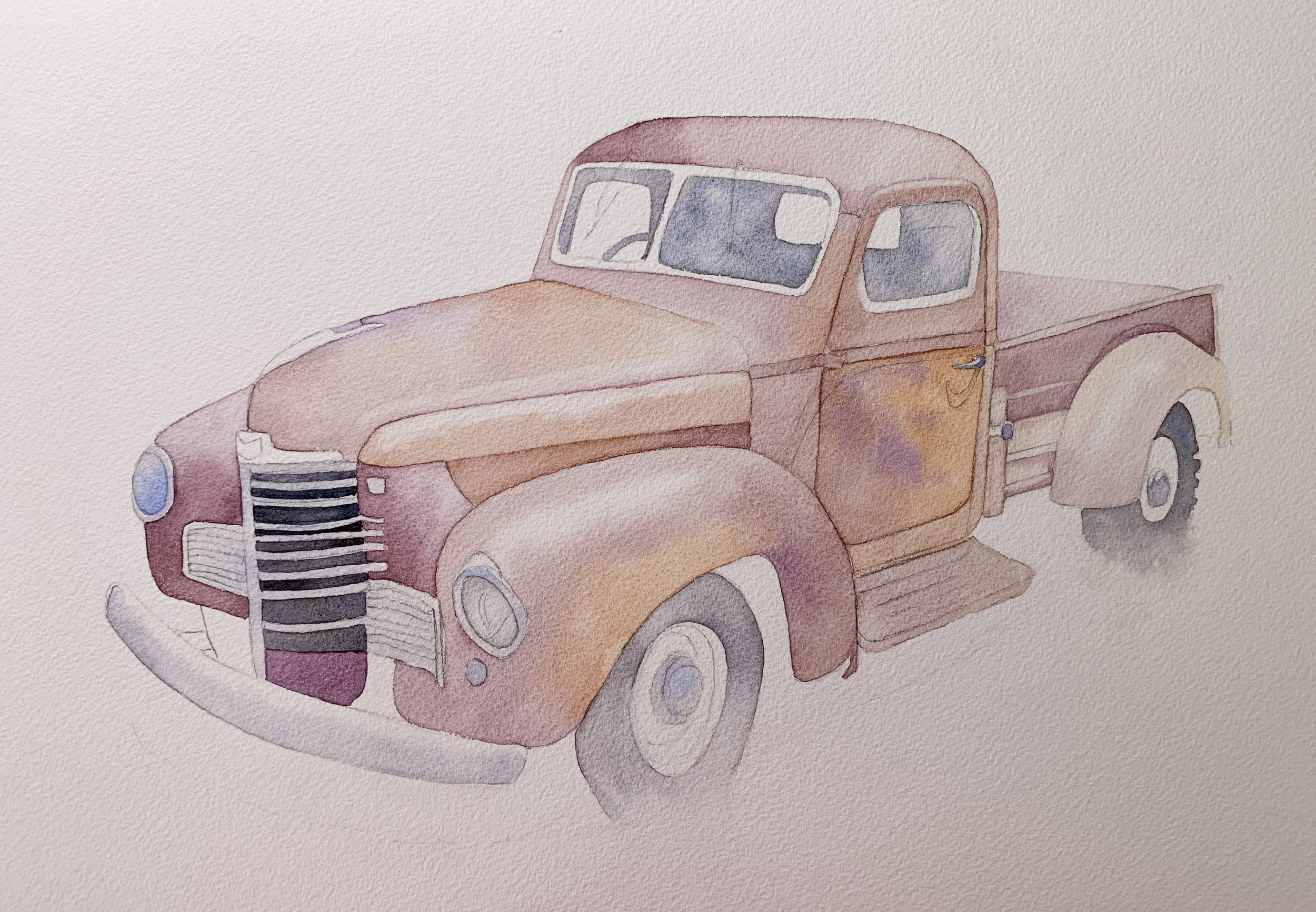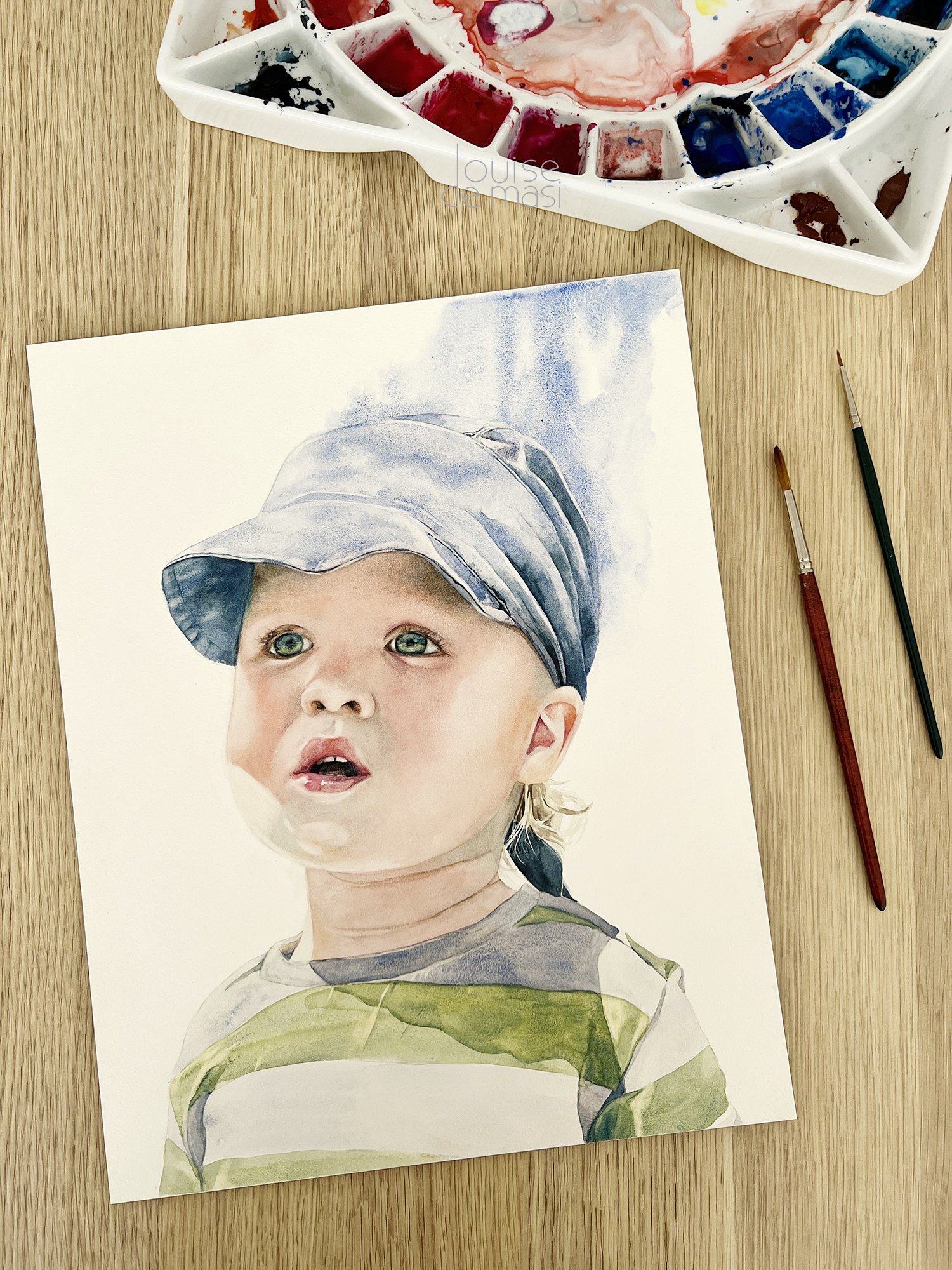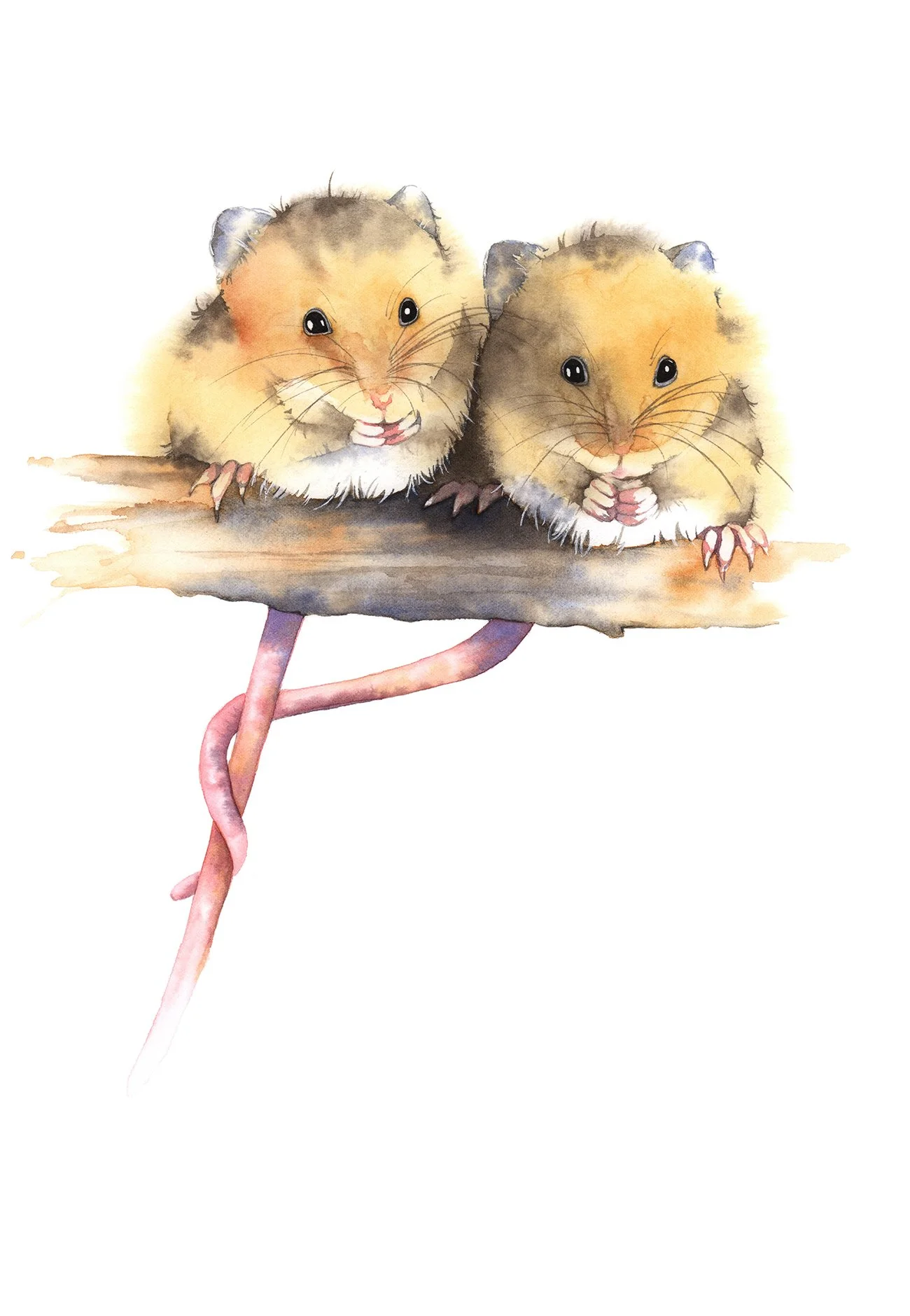16 Watercolour Tips and Tricks to make Your Life Easier
The Golden Rules of Watercolour: From universal knowledge to my own bits of wisdom
A watercolour rose painting starting to take shape.
If every question about conquering watercolour added a splash of colour to my canvas, I'd be swaying on a rainbow, painting this blog post from a cloud, surrounded by a sky full of artistic dreams and curiosities... I could write a book about everything I have learned in my watercolour journey so far, if I had the time, but for the meantime a blog post will have to suffice.
Let’s dive into the rainbow of watercolour because I’m about to spill the watercolour beans, both the universal truths and a few of my personal mantras. Buckle up, buttercup; we’re going on a colourful ride!
Universal Watercolour Wisdom
First, let’s chat about the golden rules that every watercolourist should have tattooed on their palette hand (just kidding, but not really). Without wanting to limit your creativity, the following rules will make your life as a watercolour artist a lot easier.
Water is Your Best Friend (and Worst Enemy)
Watercolour is all about balance. Too little water and your painting might look parched, too much, and it could drown. Finding that sweet spot is key to vibrant and lively artworks.
A brush - mixing water and pigment.
Imagine water as the dance partner in your watercolour tango. Like any good partner, water can lead you to create fluid, dynamic movements on the paper. However, if not in sync, it can step on your toes, causing washes to bleed uncontrollably or colours to become dull. Very little water will result in dry brush like strokes, whereas too much water will flood your paper and make the colour hard to handle.
Mastering water means practicing your steps until you move as one. Start with wet-on-wet techniques for soft backgrounds and graduate to wet-on-dry for sharp, detailed work. The key? Practice, practice, practice. And having a paper towel ready.
It's the rehearsal for your grand performance. I have written a very detailed blog post about mastering water control that you might find helpful. I also give very helpful information about paint and water consistency in this YouTube video.
Wet-on-Wet and Wet-on-Dry - Techniques to master
Embrace the fluidity of watercolour through the dual dance of wet-on-wet and wet-on-dry techniques. These two watercolour techniques are fundamental and each technique requires a bit of getting used to.
Using both the wet on wet technique and the wet on dry technique to paint some cows in a paddock.
Adding final details- wet on dry.
Geranium in watercolour used the wet-on-dry technique.
This golden rule is the yin and yang of watercolour painting, where the soft, merging colours of wet-on-wet meet the crisp, defined lines of wet-on-dry. Mastery of these techniques allows an artist to traverse the realms of expression, from the dreamlike hazes of landscapes to the sharp clarity of a striking portrait, showcasing the versatile beauty of watercolour.
In this video I am painting a Watercolour Duck while showcasing the wet-on-wet technique. If you'd like to read more about the wet on wet technique I have some tips here.
My painting of a Geranium in watercolour is all about mastering wet-on-dry technique.
To tie it all up, this blogpost will teach you when to use which techniques.
Embrace the Unpredictability: Blooms, Splatters and Tide Lines
Watercolour has a mind of its own, and that’s part of its charm. Learn to go with the flow—literally—and let those happy accidents add character and interesting texture to your work.
I love to create intentional blooms to add texture and interest to my paintings.
Watercolour is like a box of chocolates—you never know what you're going to get. But here's the secret: that's where the magic happens. Those unexpected colour blooms? They're not mistakes; they're opportunities for unique textures and effects that can't be replicated with any other medium. Embracing this unpredictability encourages a kind of painting alchemy, where you learn to turn "accidents" into artistic gold. It's about letting go and enjoying the ride, even when it takes an unexpected turn. Allow watercolour to do its magic and create interesting textures while you're at it.
Watch me learning to embrace and use watercolour blooms in this video.
Layer Like You’re Dressing for a Polar Vortex: The Art of Patience
Transparency is the name of the game and layering is one of my favourite watercolour techniques. Build your colours up from light to dark, and give each layer a chance to dry. This is how you achieve depth without muddiness.
Think of your painting as a story, with each flat wash and layer adding depth and intrigue to the tale. Layering in watercolour requires patience and foresight, planning your steps like a chess master. Each transparent layer interacts with the one beneath it, creating complex colours and luminosity that glow from within.
But beware the siren song of impatience; rushing can lead to muddy watercolour paints and lost details. Like a fine pastry, your painting needs time to rise into something deliciously complex.
Layer the paint to build the depth from light to dark.
Completed painting of the watercolour tulip.
I've made a video about the glazing technique where I paint a beautiful watercolour tulip.
White Space is Actually Something
The white areas on the Cockatoos are the white of the paper.
In watercolour, the white of the paper is your white paint. Plan ahead to leave areas untouched for highlights that pop.
The absence of colour speaks as loudly as its presence. White space is your secret weapon, a tool to draw the eye, create contrast, and add sparkle to your work. It's about strategic restraint, knowing when to hold back and let the paper breathe. This requires planning and a steady hand, as once the white space is lost, it's challenging to reclaim. Think of it as the silence between the notes in a piece of music, giving rhythm and resonance to your visual symphony.
In this painting of a cockatoo, you'll see me utilising the white of the paper to form the silhouette of the bird.
Using masking fluid can help to preserve white paper, without having to work meticulously around it. I have used it to create this watercolour painting of a heron. I have also recently shared my top tips for working with masking fluid in a blogpost. Be sure to work with the best paper you can afford, as it will give you more control and the best results.
Work Light to Dark Colours
Start your paintings with the palest washes and light colours, allowing the natural progression towards deeper shades and dark colours to add depth and detail as your work develops.
Begin with light layers
Progress towards darker colours
This approach, unique to watercolour, requires planning and foresight, layer by layer, staring with lighter colours, to gradually deepen the painting's tones. Just like day turns to night, we begin with soft light and slowly build to the vibrant colours of evening, creating a piece where every shade tells its own story.
Watercolour Paint is a transparent medium and dries paler than you'd think
Understand and anticipate the way wet paint dries lighter than it appears when wet, adapting your technique to achieve the desired outcome.
Embrace the magical transformation as your watercolour painting dries, whispering into a lighter version of its wet self. It's like watching a caterpillar turn into a butterfly, where the vibrant wet hues softly fade into delicate whispers of their former selves. Anticipate this enchanting shift, and let it guide your brush; it's like adding sugar to your tea, knowing just the right amount to stir in for that perfect sweetness. If your wash turned out too pale; don't worry. Let the layer dry and add more paint later!
Black isn't Black
Consider mixing your darks to add warmth and complexity to shadows and depths, rather than relying solely on black paint.
I mixed my own black in the painting of a black cockatoo.
I love to mix colours and I always mix my own greys and blacks. If you have followed me for a while, you'll undoubtedly know, that my favourite way to achieve them, is by mixing Burnt Sienna (or Transparent Sienna from Schmincke) and French Ultramarine. French Ultramarine is a granulating colour, which separates beautifully on watercolour paper, giving my paintings a very unique look. Instead of laying flat and dull on the white paper, like premixed greys and blacks tend to do, I am rewarded by an ever changing, exciting patch of pigment. I wrote more about mixing your own blacks in this blogpost.
Venture into the spectrum of shadows to discover the rich, vibrant black and grey mixes that lie waiting for you. This rule encourages us to explore the depths of colour, creating shadows not from the absence of light but from the harmony of hues. Mixing darks from complementary colours or using analogous shades brings a dynamic energy to shadows, making them an integral part of the painting's life force, adding dimension and drama without muting the melody of colours.
Quality Over Quantity
Not all paper is created equally. Buy 100% cotton watercolour paper if you can.
Investing in high-quality watercolour paper, paints, and brushes makes a world of difference. You don’t need a lot, but make sure what you have is the good stuff.
The tools of your trade can make or break your artistic endeavor. Quality watercolour paper absorbs water and wet paint evenly, allowing for smooth washes and crisp lines.
Professional-grade paints offer vibrant, lasting colours that won't fade or dull over time. And the right brushes can hold just the right amount of water and paint, giving you control over every stroke.
It's worth investing in the best materials you can afford, as they are the foundation upon which all your creations are built.
My Personal Palette of Rules
Now, for a sprinkle of my own unique watercolour wisdom. These are the rules I swear by, the ones that add that special je ne sais quoi to my paintings.
Limit Your Palette
Keep it simple, sweetie! Working with a limited colour palette forces you to get creative and can lead to more cohesive and harmonious pieces. Plus, it makes packing your painting kit a lot easier.
Try to limit the amount of paint colours you use to avoid mixing muddy colours and to help create colour harmony.
After reading the wonderful book "Art of a limited palette" by Hazel Sloan, I began to rethink my approach to watercolour painting and started to force myself to use a limited palette of just a couple of paints. I speak about the effect this had on my work in this video and I remain limiting my palette to this day. Read more about my journey in this blogpost.
By limiting your palette, you become the conductor of a symphony, where every note is intentional and harmonious. This constraint is not a limitation but an invitation to explore the depth and breadth of a few chosen hues. Mixing a limited palette teaches you the subtle nuances of colour and pigment, leading to a more cohesive and striking piece. This principle also simplifies decision-making, focusing your creative energies on composition and emotion rather than being overwhelmed by choices.
Plan your Paintings
As a retired school teacher I can attest to the fact that planning is everything! There's truth in the saying, 'If you fail to plan, you plan to fail.' Painting successfully in watercolour requires planning. You've got to strategise your moves, from choosing where the light will hit the most to deciding when to let the colours mingle on the paper. It’s about knowing when to tiptoe with a wet on dry technique for that crisp edge, or opting for a wet into wet approach for a surprise cuddle puddle.
Remember, in the world of watercolour, planning is your roadmap through a whimsical, watery wonderland where, without a compass, you might just end up with a puddle of mystery colours that not even a rainbow would recognise as a relative!
Control Your Edges
Edges can direct the viewer's eye around your painting.
The edge of your watercolour stroke can tell a story all its own. Hard, soft and lost edges — each has its place. A crisp clean edge for a sharp shadow, a soft one for a foggy morning, and sometimes, letting an edge disappear entirely can create a magical sense of mystery.
In watercolour, edges speak volumes. Hard edges can stop the eye, creating boundaries and defining forms. Soft edges invite the eye to move, to explore the gentle transitions of light and shadow. Lost edges, where one form blends indistinguishably into another, suggest mystery and depth, encouraging the viewer's imagination to fill in the blanks, as showcased here.
Mastering edge control is like learning the language of watercolour, allowing you to communicate with subtlety and precision. It's about knowing when to speak clearly and when to let the silence convey the message.
I made a video for beginners to help you understand watercolour edges better. The right tools will also help you achieve clean edges.
Know/Understand Your Materials
Become familiar with your materials.
Each pigment, paper, and brush has its personality. Spend time getting to know them. Which colours granulate and create texture? Which paper allows for blooms? Which brush holds the most water? This knowledge is power.
If you are having troubles figuring out all the different types of watercolour paper - this video is for you.
Get to know your brushes intimately with basic practice brush strokes.
Confused about pigment? Look no further!
Persist and Have Patience
Paint as often as you can to improve your skills but have patience with yourself.
Watercolour, like a fine wine, can’t be rushed. Allow yourself the time to practice, make mistakes, and learn from them. I know, that watercolour is a very unforgiving medium, which is hard to master. I talk more about the challenges we face within a video. That said, watercolour is a wonderful medium to learn and I am sure you can do it!
Patience is not just a virtue; it’s a necessity in the world of watercolour. Keep practicing every day and you will see results. If you need more words of encouragement - this blogpost came straight from the heart.
Cultivating a Creative Mindset: The Soil From Which Art Grows
Imagine your artistry as a garden. Techniques, rules, and materials are the seeds and water, but the soil— the very foundation of your garden — is your mindset. Cultivating a creative mindset involves nurturing qualities like curiosity, resilience, and openness to experiences.
Curiosity keeps you exploring, asking "What if?" It drives you to experiment with new techniques, combine unexpected colours, and push the boundaries of traditional watercolour.
Resilience allows you to weather the storms of frustration and self-doubt. It reminds you that each mistake is a lesson in disguise, an integral part of your artistic growth.
Openness invites inspiration from the world around you and from within. It encourages you to see beauty in the mundane, to draw inspiration from other art forms, and to remain receptive to feedback and new ideas.
This mindset is what enables you to breathe life into the rules and techniques you've learned. It transforms knowledge into expression, turning water and pigment into portals to new worlds. Cultivating a creative mindset means constantly tending to your inner garden, ensuring it remains fertile ground for your art to flourish.
The Echo of Artistic Intuition
Lastly, let's not overlook the whisper of artistic intuition. Beyond rules and guidelines lies the realm of intuition — the inner voice that guides your hand and heart. It's the pulse of creativity, often leading you to your most authentic and surprising work. Honing your intuition requires a balance of practice, reflection, and trust in your own artistic vision. It's about learning when to listen to that voice and when to challenge it, creating a dialogue between your skills and your soul.
Wrapping It Up with a Bow
A present wrapped with a bow I used for a tutorial.
Whether you’re a seasoned artist or a curious beginner, these golden rules of watercolour are your roadmap to creating artwork that not only captures the eye but also the heart.
Remember, the journey of a thousand paintings begins with a single brushstroke. So, keep experimenting, keep learning, and most importantly, keep having fun.
I’m excited to see where your watercolour adventures take you!
If you are interested in learning to paint in watercolour, I have over 170 online, voiced over watercolour tutorials for all skill levels.























